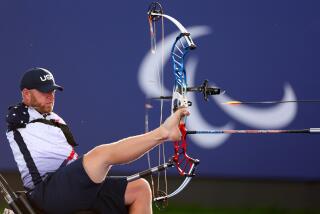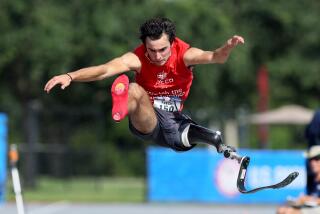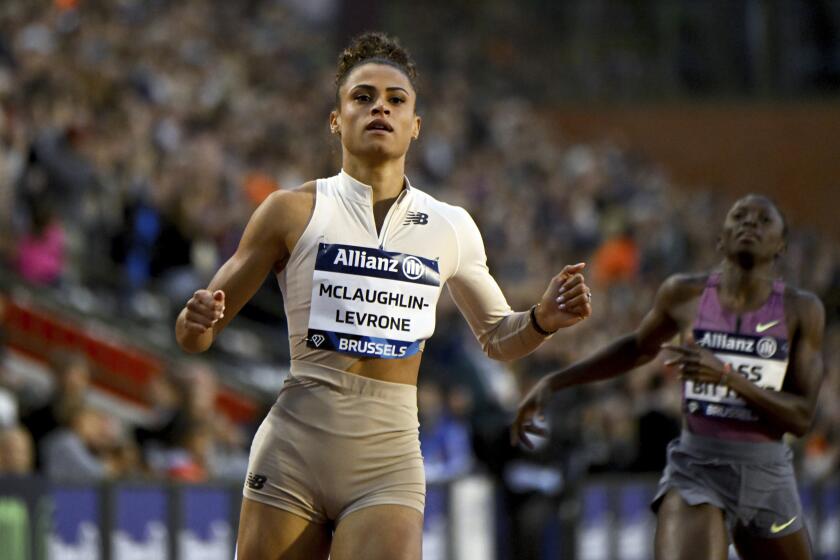Parry O’Brien, 75; champion revolutionized shotput throw
- Share via
Parry O’Brien, whose fascination with the shotput and physics fueled a career in which he held the world record from 1953 to 1959 and won two gold medals and a silver medal in four Olympic games, has died. He was 75.
O’Brien, who revolutionized the sport by devising a new throwing technique, died Saturday while participating in a masters’ swim meet in Santa Clarita. His wife, Terry, with whom he lived in the Rancho Belago section of Moreno Valley, said he had suffered a heart attack.
At his peak, O’Brien won 116 consecutive competitions. He was the first shotputter to exceed 60 feet and extended the world record from 59 feet, 3/4 inch in 1953 to 63 feet, 4 inches in 1959, raising it 16 times.
“He was one of those rare athletes who changed his sport technically, but what impressed me just as much was his remarkable consistency,” said David Wallechinsky, an author and Olympic historian.
O’Brien’s father, also named Parry, had played minor league baseball and urged his son to follow in his footsteps. But the blond youngster, nicknamed “Podge” for his husky build, resisted. Instead, he played end on the Santa Monica High football team, winning a state championship and a football scholarship to USC.
A kick in the stomach during a freshman scrimmage turned him away from football and back to the shotput, in which he had competed in high school. At USC he began experimenting with different techniques for throwing the 16-pound ball.
He would practice outside his home, in an alley outside his fraternity house at USC or sometimes alone at the Coliseum.
“I always liked the story he told about when, as a student at USC, he sneaked over the fence at the Coliseum and practiced late at night when no one was there,” Wallechinsky said.
When O’Brien began throwing the shot, the standard method was to rock back on one leg, swing the other in front for balance, hop forward and propel the iron ball forward. O’Brien instead began by facing the back of the circle. He then turned 180 degrees, using the spin to generate momentum and help him throw the shot greater distances.
The technique became known as the O’Brien Glide, and it catapulted him onto the cover of Time magazine on Dec. 3, 1956.
“It’s an application of physics which says that the longer you apply pressure or force to an inanimate object, the farther it will go,” he said in the Time article.
“My style is geared to allow me to apply force for the longest time before releasing the shot.”
He was copied by other athletes, though few enjoyed similar success. Besides his Olympic achievements, he won 18 National Amateur Athletic Union championships, 17 in the shotput and one in the discus. He won nine consecutive national indoor shotput titles and won eight overall outdoors, including five in a row.
“His impact on the sport is unprecedented,” USC track Coach Ron Allice said. “There are certain people who have been very special to the sport, and he was one of them.”
O’Brien practiced yoga, seeking to “dig deep into what you might call an inner reserve of strength,” he told Time. He also psyched himself up for meets before that became a common practice among athletes. Time reported he would play tapes of his voice that reminded him to maintain his form and speed and ended with, “And beat them! Beat them all!”
Moose Thompson, a fellow Trojan and the 1948 Olympic shotput champion, remembered O’Brien’s ferocity. “That was part of his psychological warfare on other throwers,” Thompson, 86, said Sunday from his home in Long Beach. “He was very intense. Most throwers now use that a lot, but they didn’t then.”
O’Brien was 20 and a junior at USC when he set an Olympic record of 57 feet, 1 1/4 inches at the 1952 Helsinki Games. He led a U.S. sweep ahead of Darrow Hooper and James Fuchs.
“I was very fortunate to realize my fondest ambition by winning the Olympic shotput,” he told The Times. “It was the greatest thrill of my life when I stood on the victory stand and saw the American flags go up for the first three places and heard the band play ‘The Star-Spangled Banner.’ ”
In May 1954 O’Brien eclipsed the 60-foot barrier when he reached 60 feet, 5 1/4 inches in a meet at the Coliseum. He was favored to defend his Olympic title in 1956 at Melbourne, Australia, and did not disappoint, winning with a put of 60 feet, 11 1/4 inches. He was the first man to repeat as champion since Ralph Rose in 1904 and 1908.
He nearly won a third gold medal in 1960, at Rome, but U.S. teammate Bill Nieder’s final toss beat O’Brien by nearly two feet. O’Brien took the silver medal.
In 1964, he was the flag bearer for the U.S. Olympic team at the Tokyo Games, “a signal honor,” he told The Times. He finished fourth behind Dallas Long, another USC product.
Later, after he became successful in banking, real estate and civil engineering, O’Brien competed at the masters’ level and set age-group records in the shotput and discus. He also took up competitive swimming.
O’Brien was inducted into USA Track and Field’s Hall of Fame in 1974, the U.S. Olympic Hall of Fame in 1984 and USC’s Athletic Hall of Fame in 1994.
In addition to his wife, survivors include two sons, two daughters and seven grandchildren.
At O’Brien’s request there will be no services.
*
More to Read
Go beyond the scoreboard
Get the latest on L.A.'s teams in the daily Sports Report newsletter.
You may occasionally receive promotional content from the Los Angeles Times.







